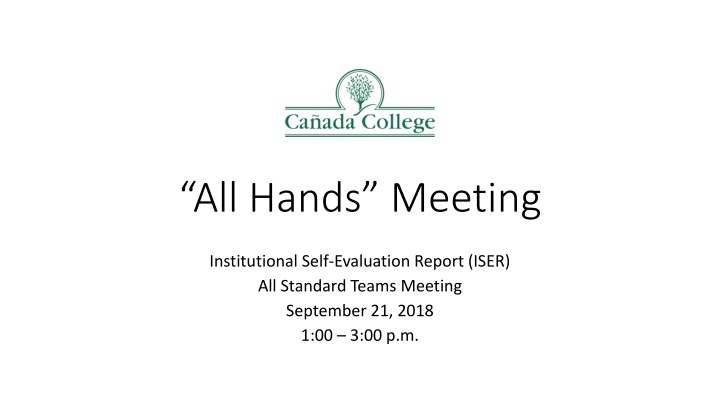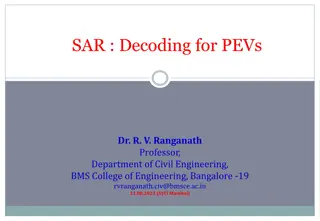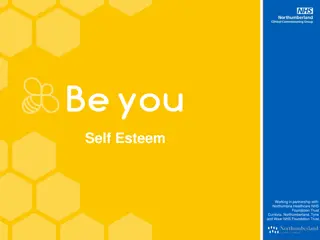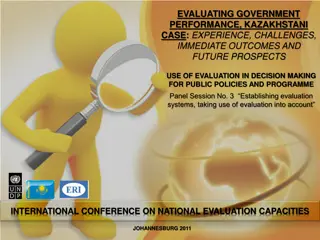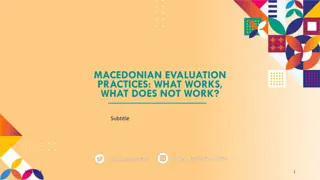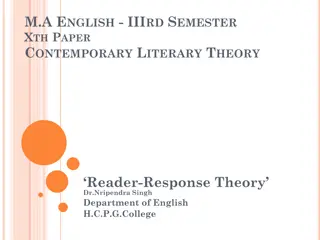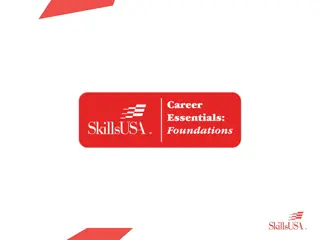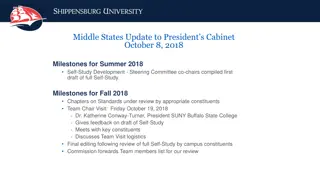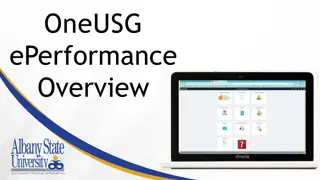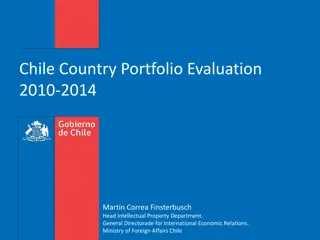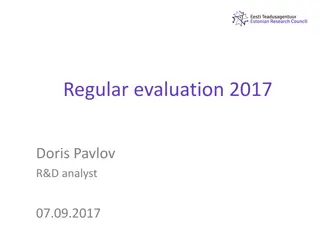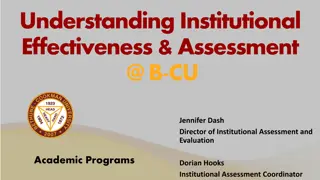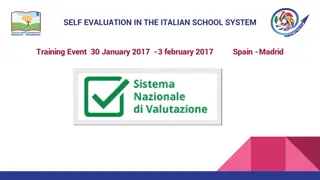All Hands Meeting Institutional Self-Evaluation Report (ISER) Summary
The All Hands Meeting on September 21, 2018, focused on updates from ISER teams, planning for feedback, Q&A with Steve Reynolds, quality focus essay review, and future steps. Discussions included aspects like the ACCJC's expectations for the Quality Focus Essay, challenges faced by colleges, storytelling in ISERs, and more.
Download Presentation

Please find below an Image/Link to download the presentation.
The content on the website is provided AS IS for your information and personal use only. It may not be sold, licensed, or shared on other websites without obtaining consent from the author.If you encounter any issues during the download, it is possible that the publisher has removed the file from their server.
You are allowed to download the files provided on this website for personal or commercial use, subject to the condition that they are used lawfully. All files are the property of their respective owners.
The content on the website is provided AS IS for your information and personal use only. It may not be sold, licensed, or shared on other websites without obtaining consent from the author.
E N D
Presentation Transcript
All Hands Meeting Institutional Self-Evaluation Report (ISER) All Standard Teams Meeting September 21, 2018 1:00 3:00 p.m.
Time Agenda Item Lunch is Served Welcome & Introductions 1:00 1:15 p.m. 1:15 1:35 p.m. Status Updates from ISER Teams Planning for Feedback from the College Community October 10, 2018 FLEX DAY 1:35 1:45 Discussion and Q&A with Steve Reynolds, Vice President, ACCJC 1:45 2:30 Quality Focus Essay Review of proposed topics or projects 2:30 2:50 p.m. Next steps and Closure 2:50 3:00 p.m.
Planning for College Feedback October 3: PBC decision on QFE topic October 10: Teams of 6-8 provide input on elements to be included in QFE (30 minutes) Report outs (15 minutes) Teams of 2 provide feedback on 28 Standard II elements (45 minutes)
Q&A What is the ACCJC looking for in the Quality Focus Essay? Is there an update on what is expected? In choosing our topic(s) for the QFE, is there a case to be made for choosing one of the areas we know we have work to do as a way to signal or acknowledge that we know we have work to do? Or is it sufficient to write about that in the ISER. What are some of the things other colleges seem to have the most difficulty with? Are there common challenges they face? Are there local or regional issues that emerge and how are colleges addressing them? For example, the cost of living in our area is extremely high, creating a challenge for students, faculty and staff. We re discussing how we will address this in our ISER, but would like to know if other colleges have discussed issues more or less unique to their region and how they have done so. Our colleagues have mentioned that, in recent trainings, the ACCJC has suggested that colleges try to tell a story with their ISER. Could you please tell us more about that? As a Basic Aid District, we are hoping that at least one member of the Visiting Team will have expertise or experience with Basic Aid districts. Is there a way to request that? Do Service Areas (like Financial Aid) need to develop and assess Student Learning Outcomes as well as Service Area Outcomes, or is it ok if they just set and assess Service Area Outcomes?
Quality Focus Essay Requirements 2-3 quality focus projects 5000 words max Identification of the Projects: The projects should be vital to the long-term improvement of student learning and achievement over a multi-year period; Desired Goals/Outcomes: The QFE should describe specific, well-defined goals expected to lead to observable results; Actions/Steps to be Implemented: The QFE (or an Appendix to the QFE) should provide the steps to be implemented for each project; Timeline: The QFE (or Appendix) should include a calendaring of all steps to be implemented; Responsible Parties: The QFE should provide clear lines of responsibility for implementation and sustainability; Resources: The QFE should include a realistic plan for the resources (human, physical, technology, or financial resources) the institution will need in order to implement and sustain the projects; Assessment: The QFE should include the institution s plan for evaluating the outcomes and effectiveness of the projects.
Identify barriers to student entry, Identify barriers to student entry, persistence, and completion and completion and address address them systematically them systematically persistence, and Capture student voice AB 705 (enhance pre-transfer student outcomes) Streamline business processes and student on-boarding Re-instate First Year Experience programming for all students Academic pathways alignment (meta majors?) Improve course schedule to facilitate student on-time completion Institutionalize and scale STEM Center innovations that support entry, persistence and completion Address transportation barriers, where possible: Shuttle Address barriers to employment or transfer for completing students
Integrate planning and budgeting to enhance Integrate planning and budgeting to enhance institutional effectiveness institutional effectiveness Restructure the program review process to make a robust, meaningful tool for program innovation and growth. Implement the updated program review and resource request timeline. Update the college prioritization process: rubrics, participatory governance access to timely, complete information, back and forth with budget development with access to better information. Align program review and strategic planning process, providing 360 degree view of college priorities, innovation, and organizational change efforts. Update the college participatory governance committee roles, structure, and meeting norms (add Business Officer/VPA as Tri-Chair to PBC)
QFE Examples Foothill College Mt. San Antonio Reedley College Shasta College
Next Steps and Closure Flex Day October 10 Address College feedback between October 10 November 16 2nd draft due to Standard Co Chairs November 16 Co-Chairs complete draft by December 12 College Forum with students in February 2019 Report finalized by March 2019
